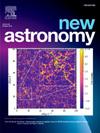Star formation rate estimations of a mid-infrared sample of X-ray selected nearby Active Galactic Nuclei
IF 2.1
4区 物理与天体物理
Q2 ASTRONOMY & ASTROPHYSICS
引用次数: 0
Abstract
We investigate the activity of active galactic nuclei and the circumnuclear star formation properties in a nearby () sample of 125 hard X-ray (14–195 keV) selected active Galactic Nuclei (AGN) from the Swift/BAT 70-month survey catalogue. Using the 11.3 polycyclic aromatic hydrocarbon (PAH) emission feature measured with the Spitzer/IRS instrument as a proxy for recent star formation, we examine the relationship between AGN power and circumnuclear star formation rate (SFR). We explored the SFR properties of both type-1 and type-2 AGN populations within our sample. A positive correlation is found between hard X-ray luminosity () and SFR for our sample but not for type-2 AGN alone. In comparing type-1 and type-2 sources, we found no significant differences between our sample’s low- and high-luminosity populations. For a subset of 50 AGN, we also provide AKARI/IRC measurements of the 3.3 PAH emission feature, which were used to estimate SFR. Although some correlations are present, these samples’ two types of AGN cannot be clearly distinguished based solely on their luminosity or SFR properties as indicated by their PAH emission.
选取活动星系核附近的中红外x射线样本的恒星形成速率估计
我们从Swift/BAT 70个月的巡天目录中选择了125硬x射线(14-195 keV)的活动星系核(AGN),研究了活动星系核的活动和环核恒星形成特性。利用Spitzer/IRS仪器测量的11.3 μm多环芳烃(PAH)发射特征作为近期恒星形成的代表,我们研究了AGN功率与环核恒星形成速率(SFR)之间的关系。我们探索了样本中1型和2型AGN群体的SFR特性。硬x射线亮度(LX)与SFR之间存在正相关关系,但与2型AGN无关。在比较1型和2型光源时,我们发现样本的低亮度和高亮度群体之间没有显著差异。对于50 AGN的子集,我们还提供了3.3 μm PAH发射特征的AKARI/IRC测量,用于估计SFR。尽管存在一些相关性,但这些样品的两种AGN类型不能仅根据其光度或SFR特性(由其多环芳烃发射表明)来明确区分。
本文章由计算机程序翻译,如有差异,请以英文原文为准。
求助全文
约1分钟内获得全文
求助全文
来源期刊

New Astronomy
地学天文-天文与天体物理
CiteScore
4.00
自引率
10.00%
发文量
109
审稿时长
13.6 weeks
期刊介绍:
New Astronomy publishes articles in all fields of astronomy and astrophysics, with a particular focus on computational astronomy: mathematical and astronomy techniques and methodology, simulations, modelling and numerical results and computational techniques in instrumentation.
New Astronomy includes full length research articles and review articles. The journal covers solar, stellar, galactic and extragalactic astronomy and astrophysics. It reports on original research in all wavelength bands, ranging from radio to gamma-ray.
 求助内容:
求助内容: 应助结果提醒方式:
应助结果提醒方式:


